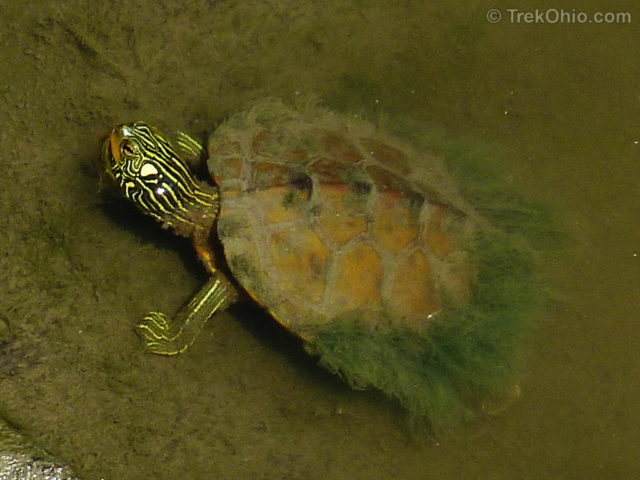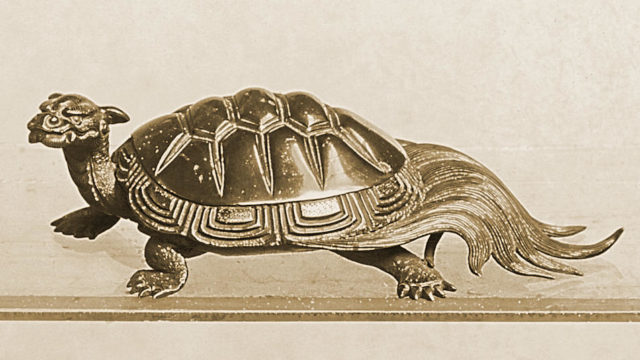When I caught sight of this turtle trailing a skirt of algae, I was immediately reminded of the similar turtles that are often depicted in Asian art.


In China such a turtle is supposed be one of four sacred animals: the turtle, the tiger (or kirin or rhino), the dragon, and the phoenix. The Japanese adopted the mythos surrounding the sacred turtle whom they refer to as the minogame. Not every turtle gets to become a minogame, just the lucky ones who have been blessed with long life. In fact the title of “minogame” is reserved for turtles who are at least 1000 years old. In art these ancient turtles are always represented with a swirling skirt of algae trailing behind them. The algae tail is supposed to make its first appearance when the turtles reach 500 years of age. The longer the algae tail, the older the turtle is supposed to be.
The turtle also personifies one of the four compass points, the north. Besides embodying longevity, the turtle of the north embodies endurance and strength. Perhaps its endurance and strength have contributed to its long life. In Asian art the turtle’s strength allows him to carry heavy burdens, and in sculpted form he often carries a stele (an engraved, upright stone that serves as a commemorative tablet). Vmenkov has developed a photo gallery of turtles bearing stelae at Flickr.
You may have noticed that the turtle in the art work above has an unusual head. This particular turtle isn’t just an ordinary, long-lived turtle. It is a bixi. I believe that bixi first entered the world of art and myth when one appeared on The Nine Dragon Scroll. The nine dragons in this famous scroll were supposed to be the sons of the Dragon King. Bixi is supposed to be the first son of the Dragon King; all the other sons look like ordinary dragons without turtle shells, but Bixi is a dragon tortoise.
However all this lore seems very lofty and far removed from Ohio. I believe the turtle in my topmost photo is a Northern map turtle, sometimes called a Common map turtle (Graptemys geographica). Since almost all the turtles that I see in central Ohio are Midland Painted Turtles or Snapping Turtles, it was exciting just to see a different species. According to the Ohio Department of Natural Resources, the Northern Map Turtle is very wary and often spends its time at the bottom of deep water. It has strong jaws and likes to eat creatures with shells, such as clams, snails and crayfish. Most surprisingly, it is the last turtle species in Ohio to go into hibernation and can be seen walking around under the ice.
I only got the briefest look at this little guy before he darted off, so I was persuaded of his wariness. And the skirt of algae made me think that he doesn’t come out of the water very often. The algae skirt may also mean he has been blessed with good fortune, and I hope that’s true. But I feel fortunate that I was able to get a glimpse of him. 🙂
Additional information
- Cultural depictions of turtles and tortoises, published by Wikipedia.
- Minogame, published at another WordPress blog, The Glyptodon
- Nine Sons of the Dragon King, published by Beyond Calligraphy
- Not a Turtle, published by Lonely Planet explaining the difference between a bixi (turtle with dragon head) and a turtle
- The Nine Dragon Scroll, published by The Circle of the Dragon
- Northern Map Turtle, published by the Ohio Department of Natural Resources
- Graptemys geographica, published by Wikipedia (about the Northern Map Turtle)
There’s an amusing and probably apocryphal story told by Stephen Hawking in “A Brief History of Time”:
Great story, Bob. 😀
Hey Bob, just checking to see if you get an email notification when I reply to one of your comments.